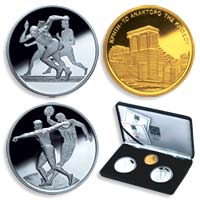|
Baptism brings great happiness to the Greek family. The special
church service with the naked infant immersed in the baptismal font
and anointed with holy oil is often followed by a joyful celebration
of feasting and dancing. Family and friends celebrate the "rebirth"
of the young child and the birth of the new relationship with the
godparent.
The Sacrament of Baptism
The sacraments of baptism and chrismation were instituted by Christ
himself when he commanded his apostles, "Go therefore and make
disciples of all nations, baptizing them in the name of the Father
and of the Son and of the Holy Spirit." (Matt. 28:19) For centuries
these sacraments have initiated the individual into the Greek
Orthodox church. Baptism cleanses the soul of the stain of original
sin transmitted to the human race by Adam and Eve when they
disobeyed God. Chrismation transmits the gifts of the Holy Spirit.
Through these two sacraments, the individual takes the first steps
toward théosis (becoming like God). Symbolically, Christ's
baptism, death, and Resurrection, plus the gift of the Holy Spirit
to the apostles at Pentecost, are reenacted.
Baptism begins in the
church narthex where the unbaptized originally congregated. The
godparent speaks on behalf of the child and forcefully rejects
Satan, including blowing three times in the air and symbolically
spitting three times on the floor.
Turning toward the
altar, the godparent professes a belief in Christ and recites the
Nicene Creed, a summary of the basic beliefs of the Greek Orthodox
Christian. Then using the child's baptismal name, the priest asks
God to make the candidate worthy of baptism by taking away old ways
and filling the child with the Holy Spirit.
The priest, child, and
godparent proceed to the front of the church to the large baptismal
font that represents the divine womb in which the child receives a
second birth as a child of God. The godparent promises to raise the
child as a good Christian.
The priest blesses the
water in the baptismal font, adding small amount of olive oil that
the godparent has brought to the church. The fruit of the olive tree
has been a symbol of peace and reconciliation between God and humans
since a dove brought an olive branch to Noah at the end of the great
flood described in the Old Testament.
The child is undressed,
symbolizing the removal of old sin. The priest makes the sign of the
cross with oil on various parts of the infant, and the godparent
rubs oil over the child's body. The oil serves as a silent prayer to
God: "O, God, let there be peace always between this child and you."
The priest immerses the child three times into the font, symbolizing
the three days Christ spent in the tomb. He declares, "The servant
of God [Name] is baptized Amen." This dramatic event is a
reenactment of Christ's baptism, reborn. The priest places the child
in the open arms of the godparent, who holds a new white sheet as a
symbol of the soul's purity.
The Sacrament of
Christmation
Immediately following the baptism, the priest administers a second
sacrament, chrismation. Like the early apostles, the child receives
the gift of the Holy Spirit during chrismation, a gift of grace from
God to help the child lead a Christian life. The priest anoints the
child with mίron,
a special oil blessed by the Ecumenical Patriarch, and says,
"The seal of the gift of the Holy Spirit. Amen." Three locks are
tonsured from the child's hair in the form of a cross. This gift to
God shows gratitude and obedience. The priest blesses a piece of the
child's new clothing, then puts it on the child with these words,
"The servant of God [name] is clothed with the garment of
incorruptibility." Relatives or friends then dress the child, and
the priest puts a necklace with a cross on the child's neck, saying,
"If any man would come after me, let him deny himself and take up
his cross and follow me." Mark 8:34
After lighting the
decorated baptismal candle, the priest, the godparent holding the
infant, and a few selected children walk around the font symbolizing
a dance of joy for the new Christian who has been added to the
church.
Following the dance and
a reading of scriptures, the priest administers a third sacrament,
communion, to the child. The child's parents approach the front of
the church where the godparent hands the infant to them with these
traditional words, "I present to you your son/daughter baptized and
confirmed, dedicated to God." The parents kiss the hand of the
godparent and receive their child.
Preparing for the ceremony
When to Baptize
Baptize your baby as
soon as possible after the forty-day blessing. (See Birth of
Children) Baptism is essential for entering heaven and participating
in other church sacraments. Since the fate of an unbaptized
individual is unknown, parents who neglect to have their child
baptized bear a heavy responsibility.
Baptisms are not permitted on the following holidays:
December 25 through
January 6, and Easter Holy Week (dates vary). Other dates, such as
major feast days, may be inconvenient or inappropriate. Exceptions
must be approved by the diocesan bishop.
Excerpt from the book Greek Traditions and Customs
|

 June
Recipe:
June
Recipe:


































 In
ancient times, according to myth, Limnos, a volcanic island, was the
home of the god Hephaistos and his most important place of worship.
The island's history is long; two of its cities, Mirina and
Hephaistia, were extremely prosperous during antiquity.
In
ancient times, according to myth, Limnos, a volcanic island, was the
home of the god Hephaistos and his most important place of worship.
The island's history is long; two of its cities, Mirina and
Hephaistia, were extremely prosperous during antiquity.






